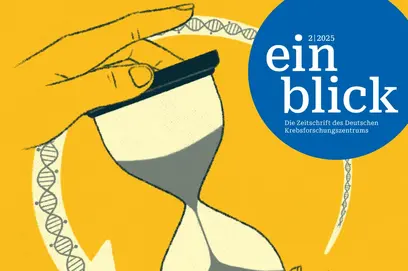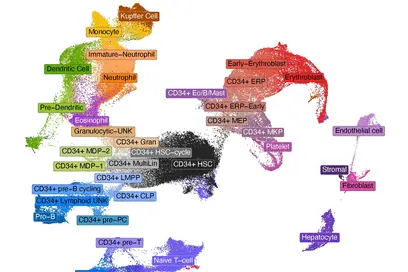Der Blutzuckerspiegel ist normalerweise sehr streng kontrolliert: Sinkt er auch nur leicht ab, produziert die Leber über die so genannte Gluconeogenese selbst Glucose, damit Gehirn und Muskeln weiter funktionieren können. Umgekehrt wird ein erhöhter Blutzuckerspiegel sofort durch die Ausschüttung von Insulin aus der Bauchspeicheldrüse gesenkt, damit die Blutgefäße langfristig keinen Schaden nehmen. „Bei Entzündungen sind diese Regelkreise jedoch gestört“, erklärt Dr. Stephan Herzig, Leiter der Nachwuchsgruppe Molekulare Stoffwechselkontrolle am Deutschen Krebsforschungszentrum. „Mit unserem neuartigen Reportersystem konnten wir aufklären, warum das so ist.“
Das Schlüsselenzym für die Zuckerneubildung in der Leber ist die so genannte Phosphoenolpyruvatkinase, kurz PEPCK. Je aktiver sie ist, desto mehr Zucker wird hergestellt, dabei regeln verschiedene Hormone ihre Aktivität: Die Stresshormone Glucagon und Cortisol kurbeln sie an, Insulin dagegen hemmt das Enzym.
In ihrem neuen Reportersystem koppelten die Wissenschaftler verschiedene Abschnitte des PEPCK-Gens an das Luciferase-Gen, das die Glühwürmchen zum Leuchten bringt. Das Konstrukt schleusten sie in lebende Mäuse ein. Anschließend riefen sie künstlich eine Entzündung in den Tieren hervor und verfolgten, welche PEPCK Genabschnitte in Antwort auf eine Entzündung aktiv waren – die Leber zum Leuchten brachten – und welche nicht – es blieb alles dunkel. Dabei zeigte sich, dass die Entzündung, wie sie bei einer Blutvergiftung auftritt, die molekulare Kooperation der beiden Hormone Glucagon und Cortisol verhindert und so die PEPCK und damit die Zuckerneubildung blockiert. Hier könnten Medikamente ansetzen, die die Blockade aufheben und die Zuckerneubildung in der Leber wieder ankurbeln. Stephan Herzig betont: „Die Ergebnisse könnten auch für Krebspatienten interessant sein, die oft unter der so genannten Kachexie leiden. Diese extreme Auszehrung des gesamten Körpers ist ebenfalls durch eine starke Entzündungsreaktion und die Fehlregulation der Zuckerneubildung gekennzeichnet und auch hier könnte man möglicherweise medikamentös eingreifen.“
In vivo PEPCK promoter mapping identifies disrupted hormonal synergism as a target of inflammation during sepsis in mice (p NA)
Evgeny Chichelnitskiy, Alexandros Vegiopoulos, Mauricio Berriel Diaz, Anja Ziegler, Anna Kleiman, Alexander Rauch, Jan Tuckermann, Stephan Herzig
Accepted Article Online: Aug 4 2009 11:35AM
DOI: 10.1002/hep.23194
Ein Foto von Stephan Herzig steht zur Verfügung unter:
www.dkfz.de/de/presse/pressemitteilungen/2009/images/Herzig_Stephan.jpg
Über das DKFZ
Das Deutsche Krebsforschungszentrum (DKFZ) ist mit mehr als 3.000 Mitarbeiterinnen und Mitarbeitern die größte biomedizinische Forschungseinrichtung in Deutschland. Wissenschaftlerinnen und Wissenschaftler erforschen im DKFZ, wie Krebs entsteht, erfassen Krebsrisikofaktoren und suchen nach neuen Strategien, die verhindern, dass Menschen an Krebs erkranken. Sie entwickeln neue Methoden, mit denen Tumoren präziser diagnostiziert und Krebspatienten erfolgreicher behandelt werden können. Beim Krebsinformationsdienst (KID) des DKFZ erhalten Betroffene, Interessierte und Fachkreise individuelle Antworten auf alle Fragen zum Thema Krebs.
Um vielversprechende Ansätze aus der Krebsforschung in die Klinik zu übertragen und so die Chancen von Patientinnen und Patienten zu verbessern, betreibt das DKFZ gemeinsam mit exzellenten Universitätskliniken und Forschungseinrichtungen in ganz Deutschland Translationszentren:
- Nationales Centrum für Tumorerkrankungen (NCT, 6 Standorte)
- Deutsches Konsortium für Translationale Krebsforschung (DKTK, 8 Standorte)
- Hopp-Kindertumorzentrum (KiTZ) Heidelberg
- Helmholtz-Institut für translationale Onkologie (HI-TRON) Mainz – ein Helmholtz-Institut des DKFZ
- DKFZ-Hector Krebsinstitut an der Universitätsmedizin Mannheim
- Nationales Krebspräventionszentrum (gemeinsam mit der Deutschen Krebshilfe)
Das DKFZ wird zu 90 Prozent vom Bundesministerium für Forschung, Technologie und Raumfahrt und zu 10 Prozent vom Land Baden-Württemberg finanziert und ist Mitglied in der Helmholtz-Gemeinschaft Deutscher Forschungszentren.



